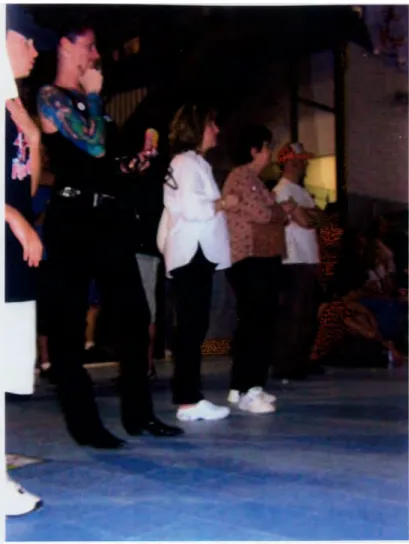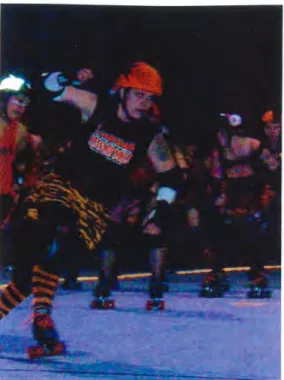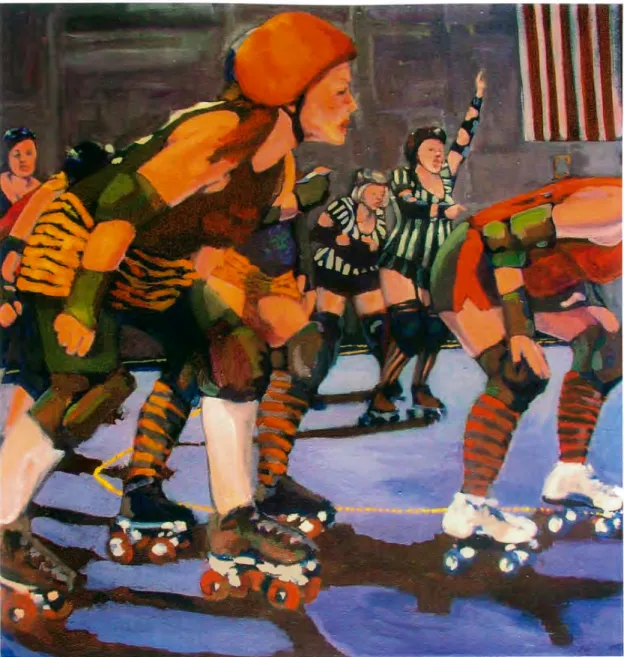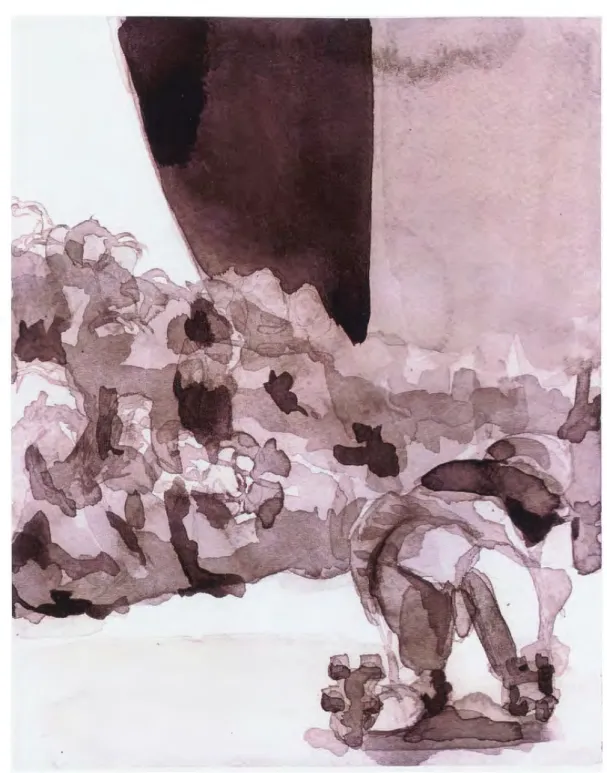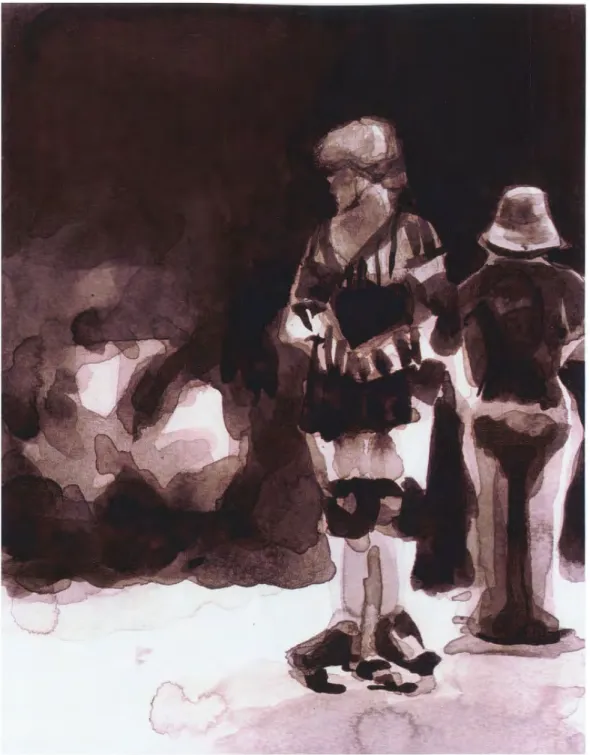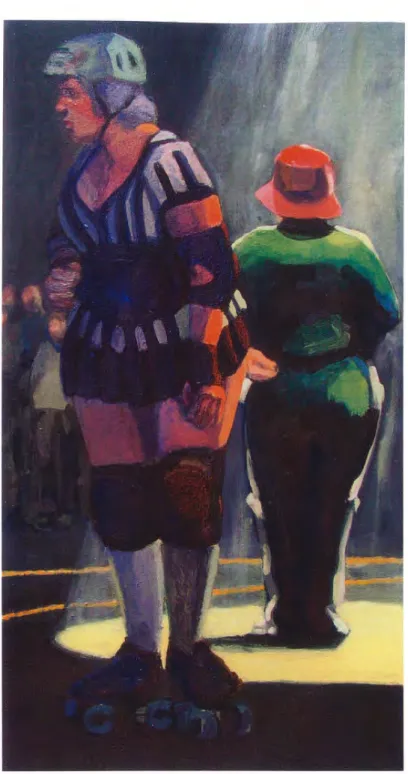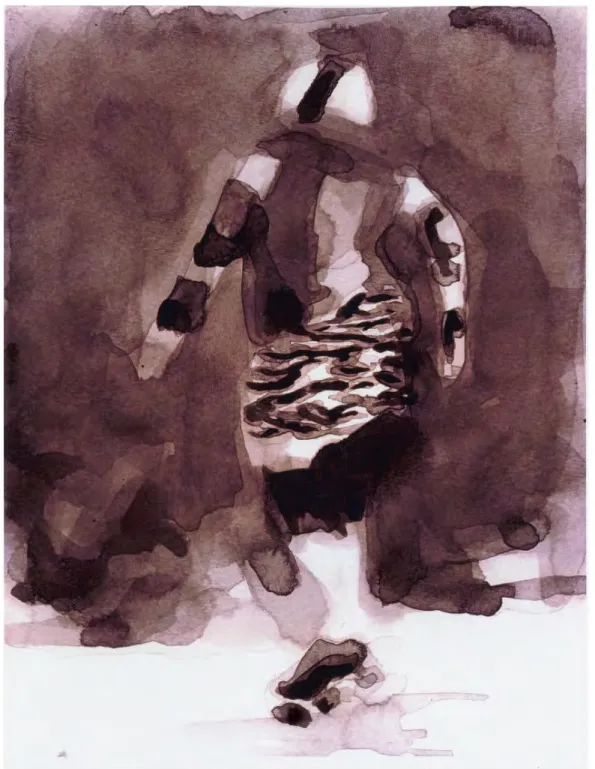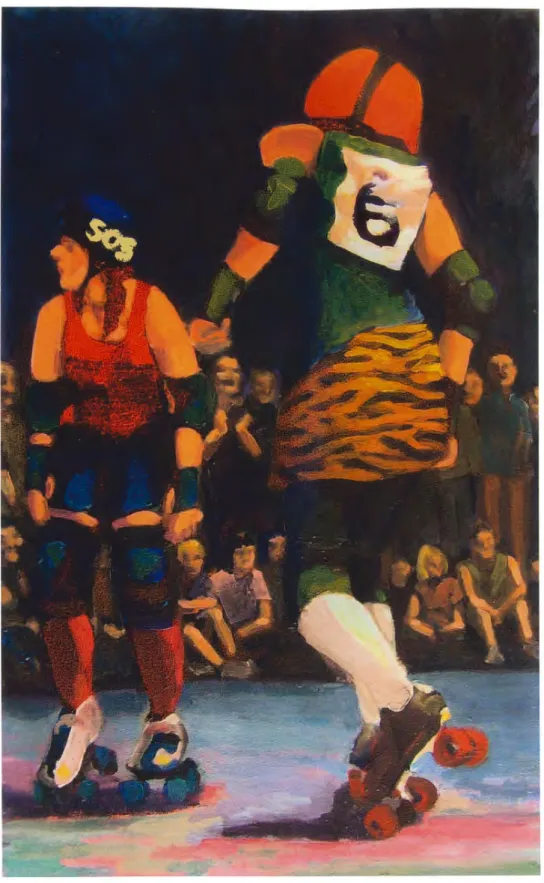THESIS
ADVENTURES IN ROLLER DERBY
Submitted by Karen Lynn Link Department of Art
In partial fulfillment of the requirements For the degree of Master of Fine Arts
Colorado State University Fort Collins, Colorado
ND237
.L668
A4
2007
COLORADO STATE UNIVERSITY
March23, 2007
WE HEREBY RECOMMEND THAT THE THESIS PREPARED UNDER OUR SUPERVISION BY KAREN LYNN LINK ENTITLED ADVENTURES IN ROLLER DERBY BE ACCEPTED AS FULFILLING IN PART REQUIREMENTS FOR THE DEGREE OF MASTER OF FINE ARTS.
Committee on Graduate work
ABSTRACT OF THESIS
ADVENTURES IN ROLLER DERBY
In my thesis, I discuss why I paint images of roller derby matches and why, in
particular, the Rocky Mountain Rollergirls. I show how I explore my subject through
narrative, compositional space, and value. I write about the relationships between the
figures, and between the figures and their environment, and how that relates to issues of
narrative. I show how I explore my subject through acrylic and india ink and the
materials that are used for my supports. I discuss how Henri Matisse and Richard
Diebenkom have influenced my work and how my work functions differently from theirs.
Also in my thesis, I discuss the use of photography and how it relates to the creative
process of my painting. Lastly, the reasons and advantages of using photography in my
process is explored including the malleability of digital photography.
Karen Lynn Link
Department of
ArtColorado State University
Fort Collins, CO 80523
Spring 2007
I would like to dedicate this to my parents, Joe E. and Phyllis E. Reed; my other parents, Dan and Catherine Link; and especially to my husband, Dean J. Link, because he loves brave women and I would never want to let him down.
The excitement of the show and the communal spirit of the crowd is what first attracted me to paint from images of Roller Derby events. Also attractive to me is capturing the strength and boldness of the skaters in my work. My process involves searching for meaning and form. Intuitive choices guide and open my work up to new avenues of investigation. The exploration of my subject is through acrylics and india ink and various support materials. My work also explores issues involving narratives
through relationships between figures as well as between figures and their environments. The two primary influences on my work are Richard Diebenkom and Henri Matisse. Photography also holds an important place throughout my creative process. There are many reasons and advantages for my use of photography, in particular, digital
photography. Digital photography allows for experimentation due to the flexibility of the image on the computer as well as after printing. It also delivers some surprises when printed, such as when the image shifts in hue, and that can influence the outcome of the painting.
The first paintings involving the women who participate in Roller Derby events were started more than a year ago after attending one of their matches at the Bladium Sports Center. This is a roller hockey rink within the old Stapleton Airport redevelopment area in Denver. Since the Rocky Mountain Rollergirl teams skating there are Denver's home teams, my work has focused primarily on them. The Rocky Mountain Rollergirls formed in the summer of 2004, the same year that the World Flat Track Derby Association (WFTDA) formed.
The combination of action and the communal spirit of the events are some of the catalysts for my explorations. Working with imagery that shows women's strength and sexual bravada in a positive and serious way is a nice counter-balance to what the mainstream presents as images of the perfect woman. On the Rocky Mountain Rollergirls' website, they state:
''The Rocky Mountain Rollergirls are a band of feisty, athletic, strong-minded chicas who have been taking Denver by storm since August 2004. We are the first and only flat-track all-female roller derby league actively practicing and bouting in Denver. We're dedicated to upholding the proud foundation upon which the great sport of roller derby is built, while delivering an updated style of play that includes body-checking, speed, punches and miles and miles of personality and style. You won't find any choreographed or made-for-1V moves on our skate track, just a righteous group of fast and flirty hot wheelettes hell-bent on living up to the
reputations the women who, since 1935, have combined hard-hitting skating with explosive rink-side entertainment." 1
Part of this entertainment is the use of alternative personas by all the participants including the referees and organizers. The play by play announcer is called Precious Moments. The 'Ref' Staff includes Betsy Blackheart, Kissa Death, Ann Gre Feminist, among others. Players include Penny Payne, Jayne Manslaughter, Icy U Hurtin, and my favorite pop-culture reference, She Who Cannot Be Named. 2 Some of these women are also business professionals, including accountants and lawyers, who have careers outside of the rink. What is attractive to me about these split personalities relates back to my own experience with jobs, and the plus and minuses of letting those around you know
1 Rocky Mountain Rollergirls. About the Rocky Mountain Roller Girls. [essay on-line]. Available from
(http://www.rockymountainrollergirls.com/content/view/27/401).
2 This is a reference to the reoccurring character "He Who Cannot Be Named" in the Harry Potter literary
series by J.K. Rowling.
that you are also an artist. The splintering of self into multiple identities based on the roles that we play is interesting because the line that divides who we are from who we pretend to be, or not to be, can be fairly blurry. This all sets a stage that can create some pretty interesting relationships. As a result, the roller derby is a show that attracts a mixed crowd and it's not uncommon to see ''traditional" families sitting side by side with extravagantly pierced and tattooed fans (see Fig. 1 ). I enjoy being caught up in the atmosphere and spend my time photographing everything that I see.
The photograph is integral to my creation process in a variety of ways including research and reference. This includes anatomical reference as well as referencing the protective gear and costumes while painting. In general, photography brings with it the ideas of truth and immediacy that I want to carry over into my work. The events and people must feel real and true to me even though the color or form in the painting may be exaggerated and depart from reality. Matisse said, "A distinction is made between artists who work directly from nature and those who work purely from imagination. Neither of these methods should be preferred to the exclusion of the other. Often both are used in turn by the same man ... " 3
The process begins with photographing the matches using a digital camera. I survey and shoot anything that appeals to me, sometimes at random or through composed images and typically average 300 photographs per event. Later, the photographic images are uploaded to my Macintosh so that I can examine and manipulate them. I'll visually scan through these images and some will catch my attention because of a certain gesture or
3 Ge~ Robert (ed.). The Painters Keys: Resource of Art Quotations. Available from (http://quote.robertgenn.com/auth _ search.php?authid=235).
action. Sometimes I'm not sure what it is that I'm attracted to in the photograph, but I'll pursue it anyway to see what I can discover.
The photos that interest me are examined for compositional and narrative inspiration. At this time, I begin manipulating the photographs either on the computer, in a software program like Adobe Photoshop, or in a more tactile approach like collage. I will
experiment with any approach that might facilitate discovery (see Fig. 2). This work is a combination of two separate photographs to enhance the narrative. One is from the roller derby, where I've selected a few skating figures and combined them with figures in an audience from a photograph of a local demolition derby match, (see Figs. 3 and 4 ).
The color in the painting begins with the color in the photograph. Inconsistencies in printing the photos can be a new source of inspiration for color. Usually the local color in the photograph is the basis of color, but it doesn't necessarily indicate what the final color will be. This is because I like to push color so that it ultimately fits in with the mood or narrative. The color of the concrete floor is an area that shifts in my work and is the most influenced by the printed photograph. This concrete floor is a generic shade of gray that can be found in most garages and carports. This gray color tends to shift to shades of blue, purple, and green when it is printed. In Fig. 5, I've pushed the color of the floor to a saturated blue purple and in Fig. 6, the floor color is a neutralized green.
One of the primary reasons I use photography comes from my mother who worked as a photographer while I was growing up. Many hours were spent with her looking and discussing her photographs and that activity carried over into my process for painting.
There are many advantages to using photography in my process. The camera has the ability to stop and capture nuances of the action between the players and referees
including facial expressions that would not necessarily be seen otherwise. The camera also crops images in a particular way that can add to the narrative (see Fig. 7). In this painting, cropping along the neck of the lead skater was done to show that she is unable to change what is occurring out of frame on the right and to symbolize defeat as that team ultimately lost the match.
The use of photography gives me the time to have an extended relationship with the image. Regular study of my photographs allows me to discover new leads and new inquiries. During these reviews, I begin to notice things that I may not have seen before. Throughout the process I'm always searching and asking, "What do I see now that didn't catch my eye before."
The advantage of a digital photograph, or any photograph for that matter, is that it creates an immediate image with an instant point of view that is easily manipulated. This allows the creation of multiple computer images from one photograph in order to explore more than one possible outcome (see Figs. 8 and 9).
I've been working with acrylic paint since I was 11 and began working with india ink during my BFA. When working with acrylic media, I use a variety of support sizes depending on what I think the painting needs. I also use a variety of supports; primarily stretched canvas, mat board or gessoed paper. With india ink, I work on a variety of papers in the range of9" x 12" and smaller.
The smaller paintings do not necessarily come into existence before the larger works. Generally one will lead to another, but most of the time "children" of the same source material are being worked on at the same time. Both Figs. 10 and 11, as well as Figs. 12 and 13, were worked on simultaneously. In Figs 10 and 11, my idea was to experiment with the relationship of the figures to one another and in Figs. 12 and 13, it was to experiment with issues of narrative as it relates to composition. Each is exploring a different aspect of the photographic image; one informing the other.
The repetition of the same or similar composition facilitates the development of an idea more fully. Sometimes there are changes in the media used, between acrylic and india ink, or a shift in scale of the support, but not always. Details within the
composition are added or removed to explore issues involving narratives. These changes allow me to come back to the image with fresh eyes and a renewed interest.
While acrylic allows me to investigate issues involving color, india ink allows me to explore more fully the issues of repetition and value. Henri Matisse said, "A colourist makes his presence known even in a simple charcoal drawing." 4 Matisse's statement is my ultimate goal in my grisaille paintings. In Fig. 14, the use of repeated similar values through a variety of shapes helps create movement. The crowd, the skates, kneepads, elbow and wrist pads are shapes with darker values that alternate with lighter values to create an undulating effect or a shifting of space to indicate movement.
In addition to repetition and patterning, my work also explores value as it relates to mood and narrative. In Figs. 15 and 16, the value structure shifts from high contrast to
4 Genn, Robert (ed.). The Painters Keys: Resource of Art Quotations. Available from
low contrast to emphasize different emotional aspects of the players. The value structure can change from figure to figure within the same work as in Fig. 17. In this work, the two figures are in different lighting situations to create a more ambiguous relationship between them.
The placement of lone figures comes from my investigation of the work by Henri Matisse (1869-1954) and Richard Diebenkom (1922-1993). Both artists worked with one or two figures within a definitive environment. I wanted my paintings to function
similarly to some of Matisse's odalisques and specifically the relationship of the three-dimensionally rendered figures to a more flatly painted environment as in Matisse's paintings (see Figs. 18 and 19).
Some of the environments the figure inhabits in my work are painted flat, but the space should feel how the space works in Diebenkom's paintings (see Figs. 20 and 21). His work is much more gestural than mine and his texture and painting technique differs quite a bit, too. That being so, his bands of color can be reduced to a dominant hue and value that recedes or advances visually toward the viewer. Richard Diebenkom said, "I would like the colors, their shapes and positions to be arrived at in response to and dictated by the condition of the total space at the time they are considered." 5
The three-dimensionally rendered figures in my work are placed in a more ambiguous environment than that of Matisse or Diebenkom. The value or color in the environment is determined by the spatial relationship of the environment as it relates to the figure. For example, in Fig. 20, the dark orange field represents the far interior wall of the building.
5 Genn, Robert (ed.). The Painters Keys: Resource of Art Quotations. Available from
The dark reddish purple field represents an advertising banner that is hanging on the orange wall. The dull yellowish-green stripe represents a short wall that is on the other side of the rink in front of the orange wall. Each band exists in a particular space from the viewer.
Figurative work lends itself to narrative. "A figure exerts a continuing and
unspecified influence on a painting as the canvas develops. The represented forms are loaded with psychological feeling. It can't ever just be painting," according to
Diebenkom. 6 When setting up the structure in my work, I'm looking for some kind of relationship surrounding the figures, but not necessarily a story. In my work, the viewer has to come up with the story. I feel narratives result from people's natural curiosity about what other people are like.
Important, for me, is the search for meaning and form and letting instinct free my work to new options that I may not have seen before. Explorations by varying means allows me to have a relationship with my subject that a singular approach might not. Both, Richard Diebenkom and Henri Matisse have been inspiring to me, especially in regard to issues of color and space. They have also influenced my work through consideration of narratives by relationships between figures as well as between figures and their environments. I want to record and express the physical power and energy of the skaters in my work and the excitement of the roller derby events, as reflected in both the skaters and crowd, alike.
6 Genn, Robert (ed.). The Painters Keys: Resource of Art Quotations. Available from
Fig. 3. Roller Derby photograph.
...
0
Fig. 19. Henri Matisse, Reclining Nude (Nu allonge), ca. 1925, Pastel on flocked
paper, 13 x 20 in. (32.9 x 50.7 em), Gift of Joseph and Enid Bissett, 1962, Allen Memorial Art Museum.
Work Cited
Genn, Robert (ed.). The Painters Keys: Resource of Art Quotations. Available from (http:/ /quote.robertgenn.com/auth _ search.php?authid=23 5).
Genn, Robert (ed.). The Painters Keys: Resource of Art Quotations. Available from (http://quote.robertgenn.com/auth_search.php?authid=32).
Rocky Mountain Rollergirls.
About the Rocky Mountain Roller Girls.
[essay on-line]. Denver: 2007. Available from (http://www.rockymountainrollergirls.com/content/ view/27 /40/).Rowling, J. K.
